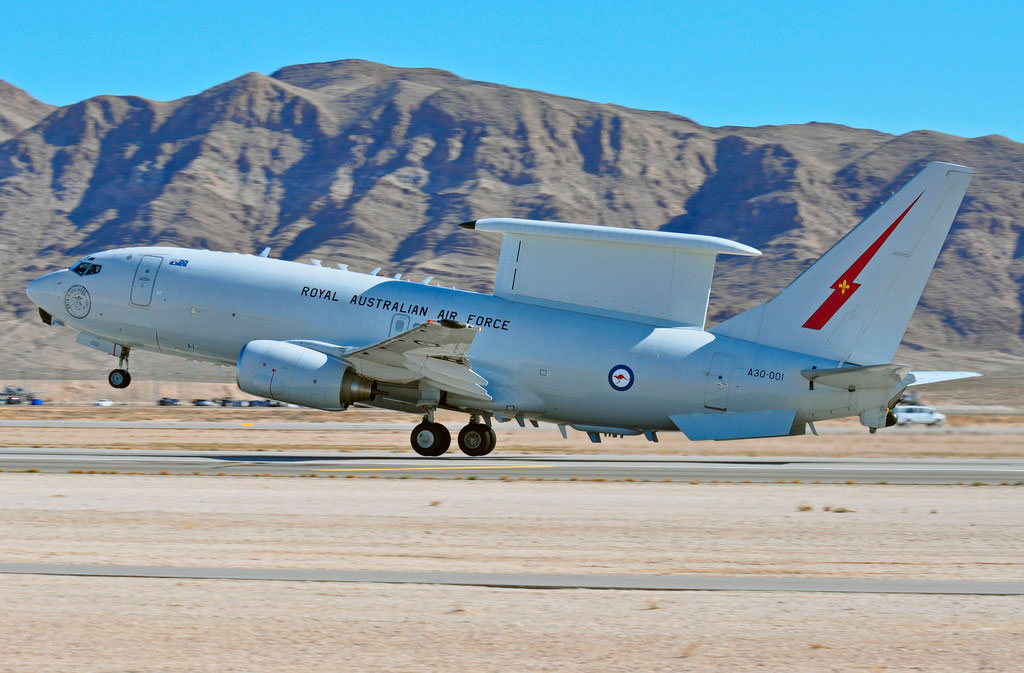Boeing E-7 Wedgetail: AEW&C platform with MESA radar, offering 360-degree surveillance, built on Boeing 737 for real-time airspace monitoring.
In brief
The Boeing E-7 Wedgetail is an Airborne Early Warning and Control (AEW&C) aircraft, based on the Boeing 737-700 platform. It is powered by two CFM56-7B turbofan engines, each delivering 27,300 pounds of thrust, with a maximum speed of 593 mph (955 km/h) and an operational range of 4,374 miles (7,040 km). Equipped with the Multi-role Electronically Scanned Array (MESA) radar, the E-7 can track airborne and maritime targets across a 360-degree field. The aircraft’s mission systems include advanced electronic surveillance measures, IFF (Identification Friend or Foe), and secure communications for integration with allied forces. First developed for the Royal Australian Air Force, the Wedgetail provides a persistent airborne command and control capability, coordinating combat operations and monitoring airspace with high endurance.
The Boeing E-7 Wedgetail
The E-7 Wedgetail was developed by Boeing in response to a growing need for advanced, multi-role AEW&C systems capable of tracking multiple targets simultaneously. Originally conceived in the late 1990s for the Royal Australian Air Force (RAAF) under Project Wedgetail, the aircraft entered service in 2009, providing real-time situational awareness to enhance command and control operations. Designed to succeed aging platforms like the E-3 Sentry, the Wedgetail uses state-of-the-art radar and avionics technology. With a fixed MESA radar mounted above the fuselage, the aircraft offers 360-degree coverage and enhanced range, which makes it effective for managing complex air and maritime environments.
History of the Development of the Boeing E-7 Wedgetail
The E-7 Wedgetail emerged from Boeing’s initiative to provide a modern AEW&C solution for global militaries. In 1999, the Australian government selected Boeing’s proposal to develop the platform, partnering with Northrop Grumman and BAE Systems to create the Wedgetail. The aircraft is based on the commercial Boeing 737-700, with extensive modifications for military use, including the integration of the MESA radar.
Initial testing faced delays due to radar integration challenges, pushing the first operational delivery to 2009. Despite these delays, the E-7 quickly proved its worth, supporting missions like the search for Malaysia Airlines Flight 370 and operations in Iraq. The platform’s ability to track up to 180 targets simultaneously and control multiple aircraft in combat scenarios underscored its operational value. Countries including Turkey, South Korea, and the United Kingdom later adopted their own variants, named Peace Eagle, Peace Eye, and AEW1, respectively.
Design of the Boeing E-7 Wedgetail
The Wedgetail’s design integrates the MESA radar atop the Boeing 737-700 airframe, offering a unique combination of stability and endurance. The radar, mounted in a stationary dorsal fin above the fuselage, provides 360-degree surveillance while minimizing aerodynamic drag. This system allows for continuous target tracking without rotating components, which reduces mechanical wear and maintenance costs.
Internally, the aircraft features consoles for mission crew and advanced avionics for situational awareness. With an MTOW of 171,000 pounds (77,565 kg), the E-7 is supported by two CFM56-7B turbofans, which enable long-duration missions. The E-7’s systems also include electronic countermeasures for self-defense, making it resilient against threats. Its open architecture allows for future upgrades, which enhances its adaptability to evolving combat requirements.

Performance of the Boeing E-7 Wedgetail
The E-7 Wedgetail’s twin CFM56-7B engines provide a total thrust of 54,600 pounds, enabling the aircraft to reach a top speed of 593 mph (955 km/h) and an operational ceiling of 41,000 feet (12,500 meters). The E-7 can cover distances up to 4,374 miles (7,040 km) without refueling, and with aerial refueling, its endurance exceeds 20 hours, allowing it to maintain continuous coverage in critical areas.
Compared to the E-3 Sentry, the E-7’s advanced radar and extended range offer improved operational flexibility. For example, in maritime surveillance, it can scan vast areas, detect sea-skimming missiles, and monitor naval movements, making it invaluable for coastal defense. The E-7’s low operational costs relative to other AEW&C platforms further enhance its appeal, as demonstrated by its selection by multiple countries for roles previously held by older platforms.
Variants of the Boeing E-7 Wedgetail
The base model E-7 is used by Australia, while variants include the Turkish Peace Eagle, South Korea’s Peace Eye, and the UK’s AEW1. Although each variant is built on the same Boeing 737-700 platform, modifications cater to specific operational requirements.
Turkey’s Peace Eagle includes custom modifications from Turkish Aerospace Industries, focusing on integration with national defense networks. South Korea’s Peace Eye emphasizes compatibility with regional defense needs, while the UK’s AEW1 replaces the E-3 Sentry, providing a seamless transition for the Royal Air Force. These variants showcase the Wedgetail’s adaptability to different national security environments.
Military Use and Combat of the Boeing E-7 Wedgetail
In military operations, the E-7 Wedgetail serves as a command and control hub, coordinating air and naval assets in real-time. Deployed over Iraq, Australian Wedgetails have directed coalition airstrikes and managed air traffic, showcasing the platform’s strategic impact. With its MESA radar, the E-7 can detect and track fast-moving aircraft, low-flying missiles, and naval vessels, making it versatile across air, land, and sea domains.
The E-7’s success led to adoption by other countries. The Turkish Air Force uses its Peace Eagle fleet for regional security and counterterrorism, while South Korea’s Peace Eye supports air defense against North Korean threats. The UK and US have recently adopted the E-7 as well, emphasizing its continued relevance in modern military operations. The E-7 remains critical in strategic deployments, such as recent NATO operations to secure supply lines to Ukraine.
Back to the Special Aircraft section